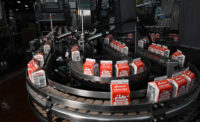Rutter’s Dairy celebrates a century of local milk
The company values long-term ties to its community and to the local farmers from which it sources its milk.












York, Pa., can trace its beginnings back to 1741, when settlers from the Philadelphia region founded the city. And Rutter’s Dairy — which is based in this area — has an origin story that goes back almost as far.
In 1747, Andrew Rutter was deeded 167 acres in York County, Pa., by Springetts Penn (the great-grandson of William Penn), the company says. This began the Rutter family’s farm operations.
But it wasn’t until 1921, when George and Bud Rutter began selling milk from said farm, that Rutter’s Dairy was officially formed. Then known as “Crystal Spring Dairy,” Rutter’s got its start as a home delivery business, says Todd Rutter, president and third-generation Rutter family member.
A lot can change in a century.
In the first years of its operations, Rutter’s was dedicated solely to home delivery. Then in the late 1960s, it began opening up its own convenience stores to compete with dairy-owned retails chains in the area, the company says. And Rutter’s completely pivoted to retail by the 1990s.
“I think a major turning point would have been the change in focus from home delivery to retail and wholesale customers,” Rutter notes.
Today the company might no longer deliver milk door to door, but consumers can find its products throughout Pennsylvania, Maryland and West Virginia.
An array of beverages
Rutter’s produces 103 SKUs in the fluid milk, tea and juice categories, says Rick Miller, sales/marketing director. The company offers fluid milk in most typical variations — nonfat, fortified nonfat, low-fat, 1%, 2% and half & half — and many formats, including gallon containers, half-gallon containers and half-pint containers. It also manufactures eggnog and an array of flavored milks.
A particularly successful flavored milk launch in recent years was Chocolate Peanut Butter milk, which was originally created as part of the company’s limited-time offer (LTO) program (see Product Development Spotlight sidebar). Peanut Butter fandom runs deep in Central Pennsylvania, where Rutter’s is located, explains Miller, in part because Hershey’s (which produces Reese’s Peanut Butter Cups) also is headquartered in the area.
“Central Pennsylvania is the peanut butter capital of the world. Peanut butter here is like bacon is to the rest of the world,” Rutter jokes. “You put peanut butter in or on anything here; it's very successful.”
While the Chocolate Peanut Butter milk was originally going to be only an LTO, it was so popular that Rutter’s decided to make it a permanent offering, Miller remarks.
“We could not make [the Chocolate Peanut Butter milk] fast enough. And then we ran out of ingredients and labels for our limited-time offer, and people were very sad,” he says. “So we retooled, and six months later, we brought it out as an everyday standard item in two sizes.”
Rutter’s chocolate milk is another very popular offering. Miller explains that the company regularly gets phone calls from fans asking if there is a way for them to ship the product out of the mid-Atlantic area. (As Rutter’s is a regional dairy, it currently does not have distribution outside of the Pennsylvania, Maryland and West Virginia areas).
“I'll get phone calls from people that have moved away from our area, begging us to ship [our] chocolate milk across the country,” explains Diane Quinn, customer service manager.
Rutter’s services most of the typical channels for dairy, including retail stores, its own and other convenience stores, schools, nursing homes, foodservice and colleges. It also produces products for some private label customers, explains Rutter.
“We're pretty much in most of them,” says Quinn.
Local before it was ‘cool’
When marketing its products, Rutter’s emphasizes its local milk source and the freshness of its products, notes Miller.
“We support local farmers,” he adds. “We're very proud of our producers, and a big part of our supply comes from those local producers that are within a hundred-mile radius of our facility.”
Rutter explains that Rutter’s has supported local farmers since its founding, and has always made products with all-natural ingredients.
"We were local before local was cool,” he points out.
Another point of marketing, at least on Rutter’s single-serve milks, is the protein content, says Miller. After noticing the consumer trend of increasing protein consumption, Rutter’s revamped its milk packaging in 2019 to call out the amount of protein.
As far as its typical customer, Miller notes that milk tends to reach across all different demographics. The amount and type of milk its customers purchased did change a bit this year with the COVID-19 pandemic. Before last year, Rutter’s had noticed a trend toward single-serve offerings.
“As people started to stay home and work from home, we saw the trend shift to our gallons and half gallons because people [returned] back to bringing the bulk sizes home,” he explains. “With restaurants and convenience stores [having a] diminished amount of people coming in for their breakfast and lunch trade, it definitely changed our product offering, as far as the volume going out.”
Rutter’s products are available at many local retail outlets, but the company has seen the most success in expanding its footprint “through private label opportunities with other distributors,” explains Rutter.
According to Miller, because today’s consumers are purchasing many beverages beyond milk, Rutter’s is competing with “everyone.” And to compete in that crowded landscape, the company focuses on producing the highest-quality product it can.
“We stick with what we do best,” Miller emphasizes. “We've been doing this a long time where we feel we're the best at what we do — making milk. Milk is our bread and butter.”
‘The best chocolate milk ever’
Rutter’s advertises digitally, on billboards and in newspapers and also runs TV ads in its local markets, notes Miller. The company produced a TV ad in 2020 that promotes its chocolate milk as “the best chocolate milk ever.” The ad highlights the special life moments into which chocolate milk fits and calls out the milk’s nutritional qualities and natural ingredients.
While events have not happened recently due to the pandemic, in the past, Rutter’s partnered with a local baseball team and did some promotion at the county fair as part of its marketing strategy. Additionally, Rutter’s works with local news stations to host Facebook Live events on the stations’ Facebook pages as part of its social media approach.
“I do a bunch of Facebook Live events every year to help promote our LTO products and also promote our seasonal products like eggnog, and those have been very successful,” Miller remarks. “[It is] a very good form of advertising that is low cost and high output … My eggnog Facebook Live got over 120,000 views in our market.”
For the eggnog video, Miller demonstrated recipes to local news anchors featuring the product, including eggnog pancakes, eggnog cookies and mixed drinks.
Rutter’s also promotes its products on its personal Facebook pages. Twice a month, it showcases its milk or flavored milk on the platform.
Developing talent locally
Rutter grew up working for Rutter’s. He jokes that while he’s officially been on staff for 43 years, he’s unofficially worked for the company since he could walk. Most of the executive team also has long-term ties to the company. Quinn has been with the company for 32 years — starting in the accounting department.
“I have worked [with] and known all three generations of owners since I've been here,” she says. “That's pretty outstanding, I think, to have that piece of history in my background.”
Miller also has been with the company for decades. He started with Rutter’s 22 years ago.
“We're very good at promoting from within,” Miller points out. “We try to develop our own talent.”
Rutter says this “homegrown” approach to building talent is part of the key to the staff’s longevity.
“Almost all my team … they worked their way up through from entry-level positions up into management, up different levels of management then up into key executive roles,” he notes.
Rutter’s “homegrown” attitude extends to its view of corporate citizenship as well. The company is very committed to giving back to its local community.
“We try very hard for our money to stay back in our market for the people that help support us; we try to help support them,” explains Rutter.
For example, Rutter’s gave almost $8 million in the past 16 years to local charities, says Rutter. These include local food banks and charities that focus on children’s issues. The company also started its own charity called Rutter’s Children’s Charities.
Making lemonade
For his part, Rutter says his perspective on the dairy industry has shifted in the past year with the pandemic, as more people returned to the dairy category during shutdowns.
“I think the last year has given the dairy industry a huge opportunity, so I think our challenge is how to exploit the opportunity the situation's given us and capitalize on it,” he explains.
Rutter views the increased milk sales during the “terrible” pandemic as a making “lemonade out of lemons” scenario.
“So, we've got the lemons, let's figure out how to make and sell lots of milk as our lemonade,” Rutter says.
Dairy is a mainstay in home cooking in general, but especially in the breakfast category, Rutter notes. He hopes that the dairy industry can find a way to capitalize on home-cooked meals even as the pandemic subsides.
“Breakfast, especially, is fluid milk's best friend,” he points out. “As all these millions of people stayed home and had breakfast for a change, hopefully they've rediscovered it. And hopefully, they appreciate the value of that quality family time, and it's a new trend.”
As far as looking to the future, Rutter’s is mainly focused on keeping its operations running smoothly during this challenging time, Rutter notes.
“Our biggest challenge each and every month is trying to figure out how to keep staffing,” he says, “and how to keep trucks rolling, and how to keep plant rolling and get through every day.
“My team and their managers underneath them have been more creative and innovative than we've ever thought we would be,” Rutter adds. “And hopefully, one of the things we've learned as a management group is that we can do this and survive. … So, maybe we can figure out how to do it a little better next time.”
Looking for a reprint of this article?
From high-res PDFs to custom plaques, order your copy today!












